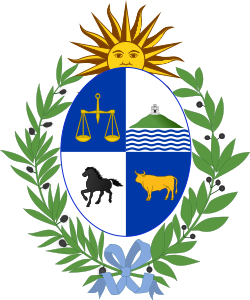Elections in Uruguay
 |
|---|
| |
Elections in Uruguay encompass three different types: general elections, departamental elections and municipal elections. At the national level, Uruguay elects a head of state (the President) and a legislature (the General Assembly). Voting is compulsory and extends to all citizens aged 18 and over.[1]
The Electoral Court sets standards for and issues guidelines to returning officers and polling station officials, and is responsible for nationwide electoral administration (such as the registration of political parties and directing the administration of elections and national referendums).[2]
2024 Uruguay general election
[edit]Voting
[edit]Electoral registration
[edit]Since voting is compulsory in Uruguay, every Uruguayan citizen upon turning 18 must register in the "National Civic Registry", an electoral roll of citizens with the right to vote, administered by the Electoral Court.[3] After registration, the person obtains the Credencial Cívica, the official document used to cast the vote.[4]
Polling procedure
[edit]
The voting procedure is detailed in Law No. 7,812 –known as the "Elections Law"–.[5] To cast the vote, Uruguayan citizens must appear before a polling station determined based on the series and number of their registration in the electoral roll.[6]
Having verified the identity of the voter and their inclusion in the electoral roll, the polling station officials give them an envelope to go to the voting booth, known as Cuarto secreto (Spanish for 'Secret room'), and insert the ballot inside, guaranteeing the secrecy of the vote.[7] Once outside the cuarto secreto, the voter places the envelope inside a closed ballot box.[8]
Presidential elections
[edit]The president and the vice-president are elected on one ballot for a five-year term by the people.
In Uruguay, a blanket primary election is held in June to elect the national convention of each party, which selects the presidential candidate. All parties must participate, however voting is voluntary unlike the other instances in the electoral process. The most voted presidential pre-candidate is automatically designated if they reach the absolute majority, or a 40% plurality with a 10% margin over the second most voted candidate. The convention also selects the vice-presidential candidate.
General elections are held in October. If no presidential candidate obtains the absolute majority of votes, there is a runoff between the two most-voted candidates.
Parliamentary elections
[edit]The General Assembly (Asamblea General) has two chambers. The Chamber of Deputies (Cámara de Diputados) has 99 members, elected for a five-year term by proportional representation with representation from the 19 departments. The Chamber of Senators (Cámara de Senadores) has 30 members elected for a five-year term by proportional representation at the national level, plus the Vice-president.
After the 2019 elections, seven parties are represented in the Chamber of Deputies and four in the Chamber of Senators.
Schedule
[edit]Election
[edit]| Position | 2019 | 2020 | 2021 | 2022 | 2023 | 2024 | 2025 |
|---|---|---|---|---|---|---|---|
| Type | Presidential (October) National Congress (October) Gubernatorial (October) | None | None | Presidential (October) National Congress (October) Gubernatorial (October) | None | ||
| President and vice president | President and vice president | None | None | President and vice president | None | ||
| National Congress | All seats | None | None | All seats | None | ||
| Provinces, cities and municipalities | None | All positions | None | None | All positions | ||
Inauguration
[edit]| Position | 2010 | 2011 | 2012 | 2013 | 2014 | 2015 |
|---|---|---|---|---|---|---|
| Type | Presidential (March) National Congress (March) Gubernatorial (March) | None | Presidential (March) National Congress (March) Gubernatorial (March) | |||
| President and vice president | March 1 | None | March 1st | |||
| National Congress | February 15 | None | February 15 | |||
| Provinces, cities and municipalities | July 8 | None | July 11th | |||
Past elections and referendums
[edit]Local elections
[edit]- 2000 Uruguayan municipal elections
- 2005 Uruguayan municipal elections
- 2010 Uruguayan municipal elections
- 2015 Uruguayan municipal elections
- 2020 Uruguayan municipal elections
- 2022 Uruguayan Law of Urgent Consideration referendum
Next elections
[edit]See also
[edit]References
[edit]- ^ "¿Hasta qué edad es obligatorio votar en Uruguay?". Telenoche (in Spanish). Archived from the original on 2024-02-09. Retrieved 2024-04-27.
- ^ "Cometidos". Corte Electoral (in Spanish). Archived from the original on 2023-12-03. Retrieved 2024-04-27.
- ^ "Largas filas para sacar la credencial, en el último día para el trámite: dónde y cómo se realiza". EL PAIS (in Spanish). 2024-04-15. Retrieved 2024-04-27.
- ^ "Credencial cívica | Trámites". www.gub.uy. Archived from the original on 2023-11-23. Retrieved 2024-04-27.
- ^ "¿Voto electrónico en Uruguay?: una "utopía" posible, pero que requiere cambiar la ley". Montevideo Portal (in Spanish). Retrieved 2024-04-27.
- ^ "Cómo votar sin la credencial y otras once dudas electorales". EL PAIS. 2019-10-26. Retrieved 2024-04-27.
- ^ Redacción. "Qué se puede hacer y qué no este domingo en el cuarto secreto". El Observador. Archived from the original on 2023-10-06. Retrieved 2024-04-27.
- ^ "En Cerro Largo hay una urna de madera de 1920". EL PAIS. 2009-10-23. Retrieved 2024-04-27.


 French
French Deutsch
Deutsch
